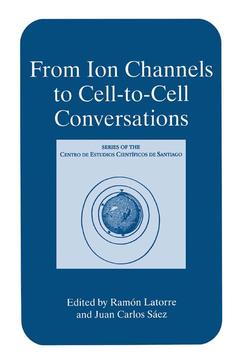Description
From Ion Channels to Cell-to-Cell Conversations, Softcover reprint of the original 1st ed. 1997
Series of the Centro De Estudios Científicos Series
Coordinators: Latorre Ramón, Sáez Juan Carlos
Language: English
Publication date: 06-2013
504 p. · 15.2x22.9 cm · Paperback
504 p. · 15.2x22.9 cm · Paperback
Description
/li>Contents
/li>Comment
/li>
Ion channels allow us to see nature in all its magnificence, to hear a Bach suite, to smell the aroma of grandmother's cooking, and, in this regard, they put us in contact with the external world. These ion channels are protein molecules located in the cell membrane. In complex organisms, cells need to communicate in order to know about their metabolic status and to act in a coordinate manner. The latter is also accomplished by a class of ion channels able to pierce the lipid bilayer membranes of two adjacent cells. These intercellular channels are the functional subunits of gap junctions. Accordingly, the book is divided in two parts: the first part is dedicated to ion channels that look to the external world, and the second part is dedicated to gap junctions found at cell interfaces. This book is based on a series of symposia for a meeting on ion channels and gap junctions held in Santiago, Chile, on November 28-30, 1995. The book should be useful to graduate students taking the first steps in this field as well as a reference for the aficionado. The aim of the meeting was mainly to show the impact of various modern techniques, including cell biology, molecular biology, biophysics, and molecular genetics techniques in the study of these ubiquitous intrinsic membrane proteins. Molecular-genetics techniques paved the road to the manipulation of the channel forming molecules.
Ion Channels in Contact with the External World. The Ways That Ion Channels Open. The Molecular Origin of Voltage Dependence in Ionic Channels; F. Bezanilla, et al. The Conduction Mahcinery of K+ Channels. Thermodynamics of Double Mutant Cycles with the Shaker K+ Channel from the Sea Urchin Sperm in the Speract; P. Labarca, et al. Ion Channels and Volumen Regulation. Anion Channels Involved in Volumen Regulation: A Common Pathway for Chloride and Organic Osmolyte?; A. Stutzin, et al. Signal Transduction. Inhibitory Responses to Odorants in Vertebrate Olfactory Neurons; J. Bacigalupo, et al. Intercellular Channels. Ion Channels that Allow Cells to Gossip. Structure and Function of Cell-to-Cell Channels Purified from the Lens and Hemichannels Expressed in Oocytes; G. Zampighi, et al. Regulation of Gap Junctions. Gap Junctions between Leukocyte and Endothelium: Expression of Connexin 43 in Adherent or Activated Cells; M.P. Boric, et al. Functional Aspects of Gap Junctions. 20 Additional Articles. Index.
The text addresses the impact of cell and molecular biology, biophysics, and molecular genetics techniques in the study of ion channels. Contributions discuss such topics as the molecular origin of voltage dependence in ion channels, different aspects of calcium-activated K+ channels of large conductance, progress in gap junction tunnels, and the process of exocytosis.
© 2024 LAVOISIER S.A.S.




